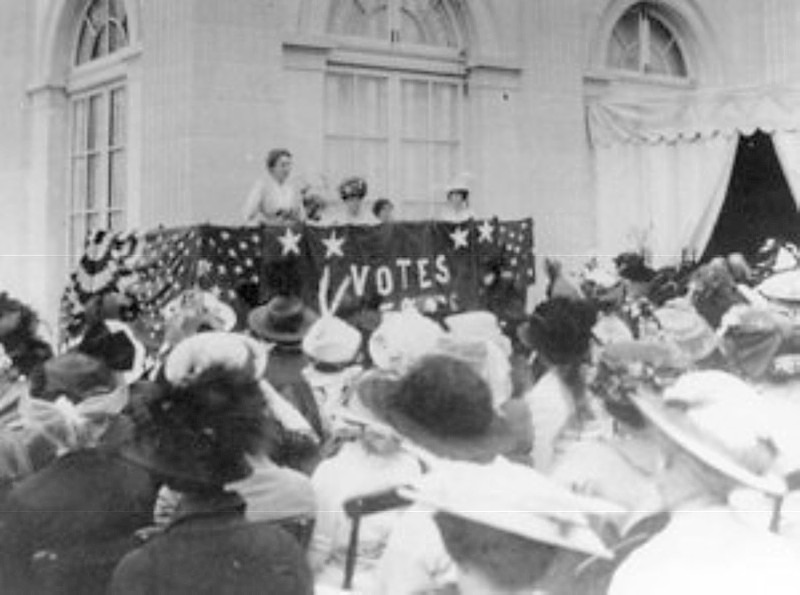
On Equal Pay Day, March 12, the Biden Administration marked celebrate how far we have come—and how far we have yet to go—in closing the gender pay gap. Under the Biden-Harris Administration, America has seen an unprecedented—and equitable—economic recovery, building back an economy that is the strongest in the world. Women’s labor force participation is the highest it has been in decades, and the gender pay gap is the narrowest it has ever been on record.
At the same time, President Biden recognizes we still have work left to do. Women workers are still paid on average only 84 cents for every dollar paid to men. And the disparities are even greater for many women of color. These inequities cost women more than $1 trillion every year, and add up to hundreds of thousands of dollars lost over the course of a career for individual workers.
President Biden and Vice President Harris remain committed to closing gender and racial wage gaps and ensuring all people have a fair and equal opportunity to participate in the labor force and support their families. Closing wage gaps is critical to strengthening and growing the economy. This Equal Pay Day, the Biden-Harris Administration reaffirms its commitment to tackling pay gaps and announces new efforts to continue to build our understanding of pay disparities, address inequities, and support women’s economic security.
These actions will:
- Promote equitable access to good-paying jobs. Last week, the President signed the Executive Order on Scaling and Expanding the Use of Registered Apprenticeships, which will expand and diversify Registered Apprenticeship programs, benefitting women and other underrepresented workers by increasing access to high-quality pathways to good-paying, family-sustaining jobs.
- Support equal pay and further understanding of pay inequities. Today, for the first time, the Equal Employment Opportunity Commission (EEOC) is making available aggregate pay data from 2017 and 2018—collected from private employers and Federal contractors with 100 or more employees—via a user-friendly interactive tool, allowing researchers, stakeholders, and the public to better understand pay disparities based on sex, race/ethnicity, geography, industry, job category, and more.
- Address occupational segregation. Today, the Department of Labor (DOL) is issuing an update to the Bearing the Cost report, analyzing the impact of “occupational segregation” on women’s economic security, particularly for Black and Hispanic women. Occupational segregation—the overrepresentation of women and people of color in occupations and industries that pay less, and their underrepresentation in occupations and industries that pay more—is a key contributor to pay inequity. DOL found that, over the course of a year, Black women lost $42.7 billion and Hispanic women lost $53.3 billion in wages compared to white men due to the impacts of occupational segregation.
Today’s announcements follow recent actions the Biden-Harris Administration has taken to further pay equity and transparency. On Equal Pay Day 2022, the President issued an Executive Order that committed to eliminate discriminatory pay practices in the Federal government and Federal contracting workforces. In January 2024, the Administration made good on that promise by committing to:
- Advance pay equity for Federal workers. The Office of Personnel Management (OPM) published a final rule ensuring that more than 80 Federal agencies will no longer consider an individual’s non-Federal current or past pay when determining the salaries of Federal employees. Ending the consideration of salary history in pay-setting decisions is a proven way to curb pay discrimination that often follows workers from job to job.
- Promote economy, efficiency, and effectiveness in Federal contracting by advancing pay equity and pay transparency laws. The Federal Acquisition Regulatory (FAR) Council issued a proposal to prohibit Federal contractors and subcontractors from seeking and considering information about job applicants’ compensation history for employment decisions for personnel working on or in connection with a government contract. In addition, the proposal would require Federal contractors and subcontractors to disclose expected salary ranges in job postings, a policy shown to reduce pay inequities. These proposals will also help Federal contractors recruit, diversify, and retain talent; improve job satisfaction and performance; and reduce turnover—all factors associated with promoting the economy, efficiency, and effectiveness of the Federal contractor workforce.
- Affirm equal pay obligations for Federal contractors. DOL’s Office of Federal Contract Compliance Programs (OFCCP) issued new guidance clarifying existing protections against discrimination in hiring or pay decisions. The guidance will help Federal contractors and employees understand when reliance on an individual’s compensation history for hiring or pay decisions may result in unlawful discrimination.
These efforts build upon actions the Biden-Harris Administration has taken to close gender and racial wage gaps and strengthen women’s economic security, which has led to the lowest unemployment rate among women since 1953. These include:
- Ensuring women have access to good-paying jobs being created by the President’s Investing in America agenda. The Biden-Harris Administration’s investments through the American Rescue Plan (ARP), Bipartisan Infrastructure Law (BIL), CHIPS and Science Act, and Inflation Reduction Act (IRA) have created thousands of good-paying jobs in industries of the future. The Administration has taken steps to ensure increased access to these jobs, including for women, people of color, and members of other communities currently underrepresented in these growing sectors have equitable access to these careers. These steps include:
- Launching the Good Jobs Initiative. DOL’s Good Jobs Initiative provides critical information to workers, employers, and government agencies to improve job quality, empower workers, and ensure workers, especially those from underserved communities, can access good union jobs free from discrimination and harassment. The Initiative is dedicated to advancing the Departments of Labor and Commerce’s Good Jobs Principles, which address recruitment and hiring; diversity, equity, inclusion, and accessibility; and pay. Key implementing agencies have signed memoranda of understanding with DOL to support the Good Jobs Initiative, promote equitable workforce development, and ensure workers have what they need to deliver on the President’s once-in-a-generation Investing in America agenda.
- Expanding access to good-paying construction jobs. To ensure women can access the almost 200,000 new construction jobs expected from the Biden-Harris Administration’s historic investments, the Department of Commerce launched the Million Women in Construction initiative, which calls on chip manufacturers, construction companies and unions to bring one million women into the construction industry over the next decade, roughly doubling women’s representation in the industry. DOL also launched the Mega Construction Project (Megaproject) Program, which fosters equal employment opportunity on designated BIL- and CHIPS-funded construction projects through intensive on-the-ground assistance to remove hiring barriers and promote consideration of a diverse pool of qualified workers, including women, people of color, veterans, and people with disabilities.
- Improving access to child care for the semiconductor workforce through CHIPS and Science Act implementation requirements. The Department of Commerce’s implementation of the CHIPS and Science Act included a historic requirement that applicants requesting over $150 million in direct funding submit plans to provide accessible, affordable, high-quality child care.
- Launching the Good Jobs Initiative. DOL’s Good Jobs Initiative provides critical information to workers, employers, and government agencies to improve job quality, empower workers, and ensure workers, especially those from underserved communities, can access good union jobs free from discrimination and harassment. The Initiative is dedicated to advancing the Departments of Labor and Commerce’s Good Jobs Principles, which address recruitment and hiring; diversity, equity, inclusion, and accessibility; and pay. Key implementing agencies have signed memoranda of understanding with DOL to support the Good Jobs Initiative, promote equitable workforce development, and ensure workers have what they need to deliver on the President’s once-in-a-generation Investing in America agenda.
- Increasing access to affordable care and supporting caregivers. Access to affordable, high-quality care is essential to ensuring parents, especially moms, can participate fully in the workforce. From day one, the Biden-Harris Administration has focused on ways to lower child care costs for hardworking families and improve wages for child care workers. The ARP Child Care Stabilization program delivered historic support to over 225,000 child care programs serving as many as 10 million children across the country. Over 90% of the child care programs that have received assistance are women-owned. The Council of Economic Advisors found that this stabilization funding supported savings for families with young children, raised the real wages of child care workers, and helped hundreds of thousands of women with young children enter or re-enter the workforce.
In addition, in April 2023, President Biden signed an Executive Order with more than 50 directives to nearly every cabinet-level agency to increase access to affordable, high-quality care and boost job quality for early educators and long-term care workers, who are disproportionately women of color. Among the many actions agencies have taken, the Department of Health and Human Services finalized a rule strengthening the Child Care and Development Block Grant (CCDBG) program and lowering child care costs for more than 100,000 families.
- Increasing the minimum wage. The President issued Executive Orders directing the Administration to work toward ensuring that employees working on Federal contracts and Federal employees earned at least a $15 per hour minimum wage. Those directives went into effect in January 2022, raising the wages of about 370,000 Federal employees and employees of Federal contractors. In addition to helping the government do its work more efficiently, these directives take a step towards narrowing racial and gender disparities in income, as many low paid workers are women and people of color. The order also eliminates the subminimum wage for workers with disabilities on Federal contracts. The President has called on Congress to raise the Federal minimum wage to $15 an hour, so that American workers can have a job that delivers dignity and to make greater strides towards pay equity.
Supporting women-owned businesses and entrepreneurs. Under the Biden-Harris Administration, Small Business Administration-backed loans to women-owned small businesses are up more than 60 percent, totaling $5.1 billion in lending to women-owned businesses in FY23. And a new report found that from 2019 to 2023, women’s small business formation surged, substantially outpacing overall formation. This Administration has invested $70 million in the Women Business Centers (WBC) network, expanding it for the first time into all 50 states and tripling the number of WBCs at Historically Black Colleges and Universities, Hispanic-Serving Institutions, and other minority-serving institutions. President Biden is also investing $10 billion through the ARP State Small Business Credit Initiative (SSBCI) to help States, territories, and Tribal governments leverage tens of billions more in matching public and private dollars to support small businesses across the United States, with a particular focus on historically underserved entrepreneurs, including women business owners. The ARP Restaurant Revitalization Fund helped over 40,000 women-owned restaurants and bars—thanks in part to steps taken by the Administration to ensure that women-owned and socially and economically disadvantaged businesses were able to access assistance.






